Thunder Bay – TECH – There have been reports across the web of Mac computer users experiencing problems upgrading to the latest version of the Mac OS Monterey.
Reports of older Macs “bricking” or freezing during the upgrade have been surfacing on user forums on Apple and other websites.
While many Mac users are likely to wait for the next upgrade this time out of concerns for their computers, there is a fix for the problem.
Revive or restore an Intel-based Mac with Apple Configurator 2
In very rare circumstances, such as a power failure during a macOS update or upgrade, a Mac may become unresponsive and so the firmware must be revived or restored.
Important: First try reviving the computer. If that fails or if you can’t start the Mac from the startup volume, recoveryOS, or Internet Recovery, you must restore the firmware and erase the internal flash storage.
What does a revive do to your Mac?
A revive updates the firmware on the Apple T2 Security Chip. A revive is designed to not make any changes to the startup volume, the user’s data volume, or any other volumes. User data may be retained if recoverable.
What does a restore do to your Mac?
A restore updates the firmware and erases recoveryOS and macOS on your internal storage. When this process is complete, any data on any internal volumes is unrecoverable.
You must restore the firmware and erase the internal flash storage if:
- Reviving the firmware was unsuccessful
- You can’t start the Mac from the startup volume, recoveryOS, or Internet Recovery
Before you begin
These revive and restore instructions cover the following Intel-based Mac computers with an Apple T2 Security Chip:
- iMac (2020)
- Mac Pro (2019)
- Mac mini (2018)
- iMac Pro (2017)
- MacBook Pro (13-inch, 2020, Four Thunderbolt 3 Ports)
- MacBook Pro (13-inch, 2020, Two Thunderbolt 3 Ports)
- MacBook Pro (13-inch, 2019, Four Thunderbolt 3 Ports)
- MacBook Pro (13-inch, 2019, Two Thunderbolt 3 Ports)
- MacBook Pro (13-inch, 2018, Four Thunderbolt 3 Ports)
- MacBook Pro (16-inch, 2019)
- MacBook Pro (15-inch, 2019)
- MacBook Pro (15-inch, 2018)
- MacBook Air (Retina, 13-inch, 2020)
- MacBook Air (Retina, 13-inch, 2019)
- MacBook Air (Retina, 13-inch, 2018)
Make sure you have:
- The latest version of Apple Configurator 2 installed on a Mac running macOS 10.15.6 or later
- Internet access
You may need to configure your web proxy or firewall ports to allow all network traffic from Apple devices to Apple’s network 17.0.0.0/8. For more information on the ports used by Apple products, see the Apple Support article Use Apple products on enterprise networks. For more information on whether your network uses a web proxy or firewall, consult your router manual or your internet provider.
- A supported USB-C to USB-C charge cable, such as the one sold by Apple (may not be available in all countries or regions) or a supported USB-A to USB-C cable
The USB-C cable must support both power and data. Thunderbolt 3 cables aren’t supported.
How the revive and restore processes work
The revive and restore processes involve the following steps:
Step 1. Plug the Mac computers together with a supported USB-C cable, locate Apple Configurator 2 in the Applications folder or in Launchpad, then launch Apple Configurator 2 on the first Mac.
Step 2. Restart the second Mac using a special key sequence. The key varies according to the type of Mac you want to revive or restore.
Step 3. Use Apple Configurator 2 to revive the Mac.
Step 4. If a revive is unsuccessful, you can use Apple Configurator 2 to restore the Mac.
Step 1: Connect the Mac computers
1. Make sure your first Mac is plugged into a power source and started.
Important: Don’t launch Apple Configurator 2 until after you have connected both Mac computers with the USB-C cable.
2. Plug in the USB-C cable (along with any adapters needed) and connect the two Mac computers.
Step 2: Prepare the Mac you want to revive or restore:
If reviving or restoring an iMac (2020) or iMac Pro (2017):
1. Disconnect the iMac Pro or iMac from power.
2. Plug the USB-C cable into the Thunderbolt port closest to the Ethernet port.
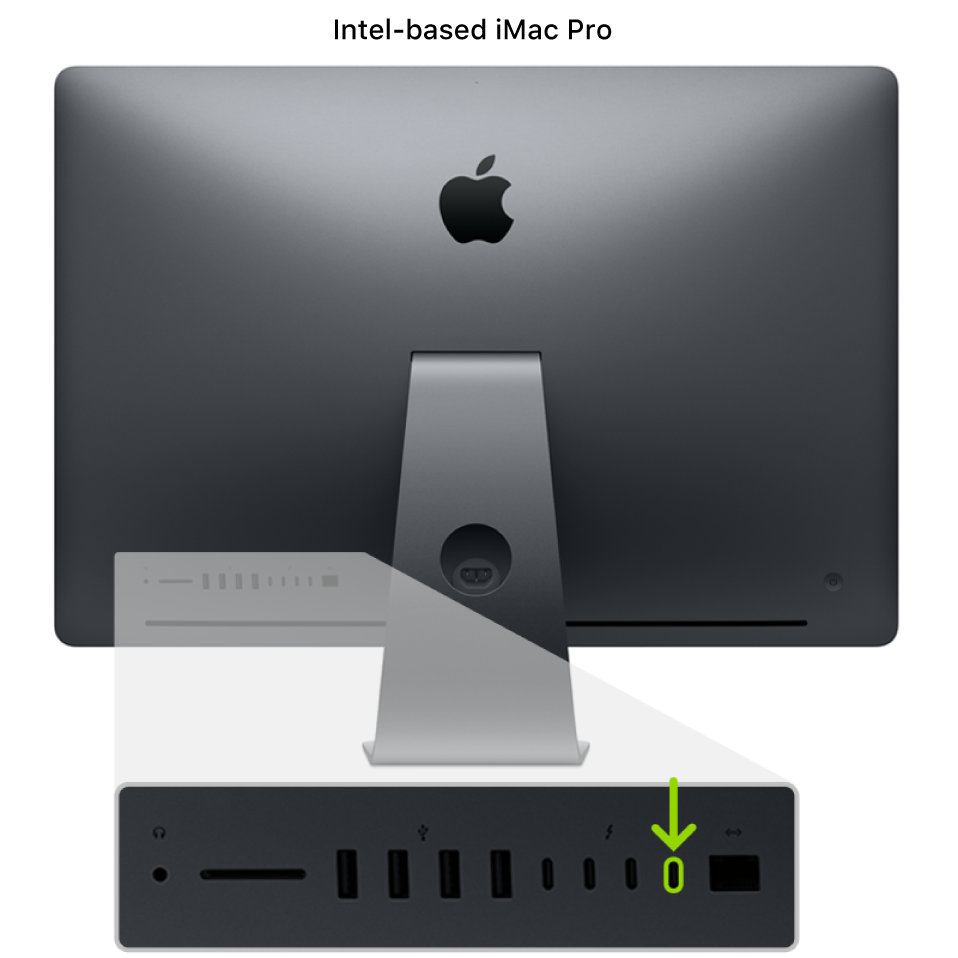

3. While holding down the power button, connect the iMac Pro or iMac to power and continue to hold the power button for about 3 seconds.
Note: You won’t see any screen activity from the iMac Pro or iMac you are trying to revive or restore.
If reviving or restoring a Mac mini (2018):
1. Connect a monitor to your Mac mini (so you can see when the process is complete).
2. Disconnect the Mac mini from power for at least 10 seconds.
3. Plug the USB-C cable into the Thunderbolt port closest to the HDMI port.
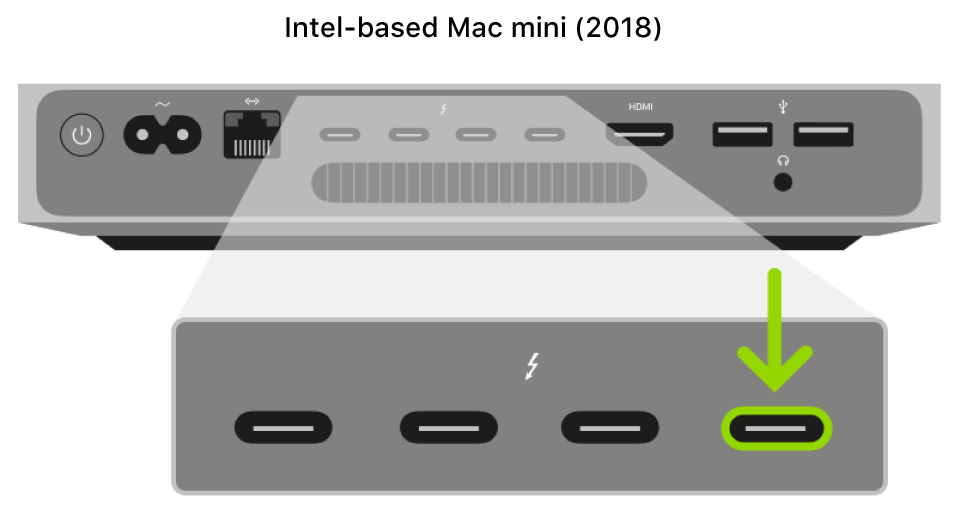
4. While holding down the power button, connect the Mac mini to power and continue to hold the power button for about 3 seconds.
Note: You won’t see any screen activity from the Mac mini you are trying to revive or restore.
If reviving or restoring an Intel-based Apple notebook computer:
1. Press the Sleep/Wake button for about 5 seconds to shut down the Apple notebook computer.
2. Plug the USB-C cable into the front Thunderbolt port on the left side of the Apple notebook computer.

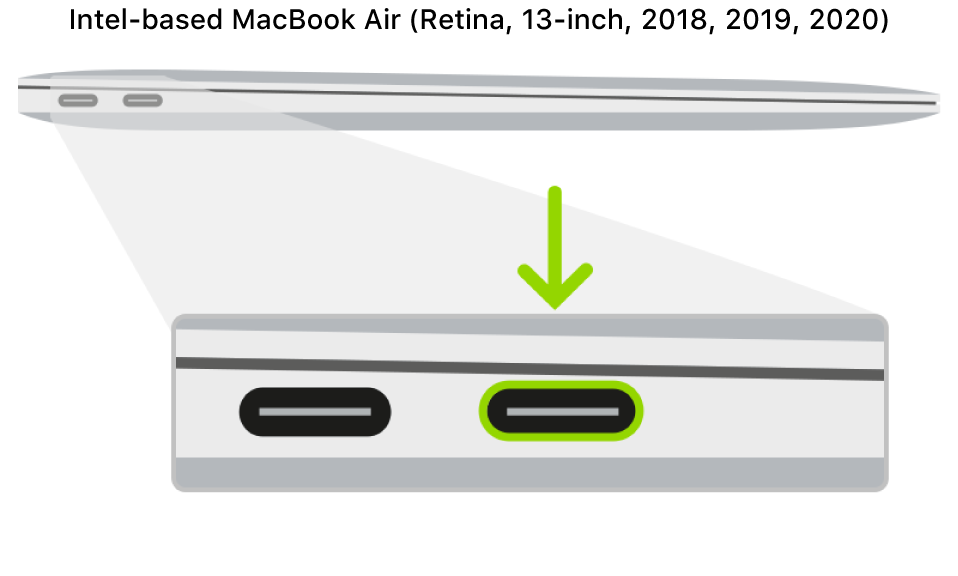
3. While holding down the power button, at the same time press all three of the following keys for about 10 seconds:
- The right Shift key
- The left Option key
- The left Control key
Note: You won’t see any screen activity from the Apple notebook computer you are trying to revive or restore.
If reviving or restoring a Mac Pro (2019):
You need to revive the firmware in a Mac Pro if the light turns amber and flashes the following sequence in under 4 seconds: three short flashes, three long flashes, and three short flashes again. For more information, see the Apple Support article Mac Pro (2019) status indicator light behavior.
1. Connect a monitor to your Mac Pro (so you can see when the process is complete).
2. Disconnect the Mac Pro from power, then do one of the following:
- For the desktop Mac Pro, plug the USB-C cable into the Thunderbolt port farthest away from the power button.

- For the rack mount Mac Pro, plug the USB-C cable into the Thunderbolt port closest to the power button.
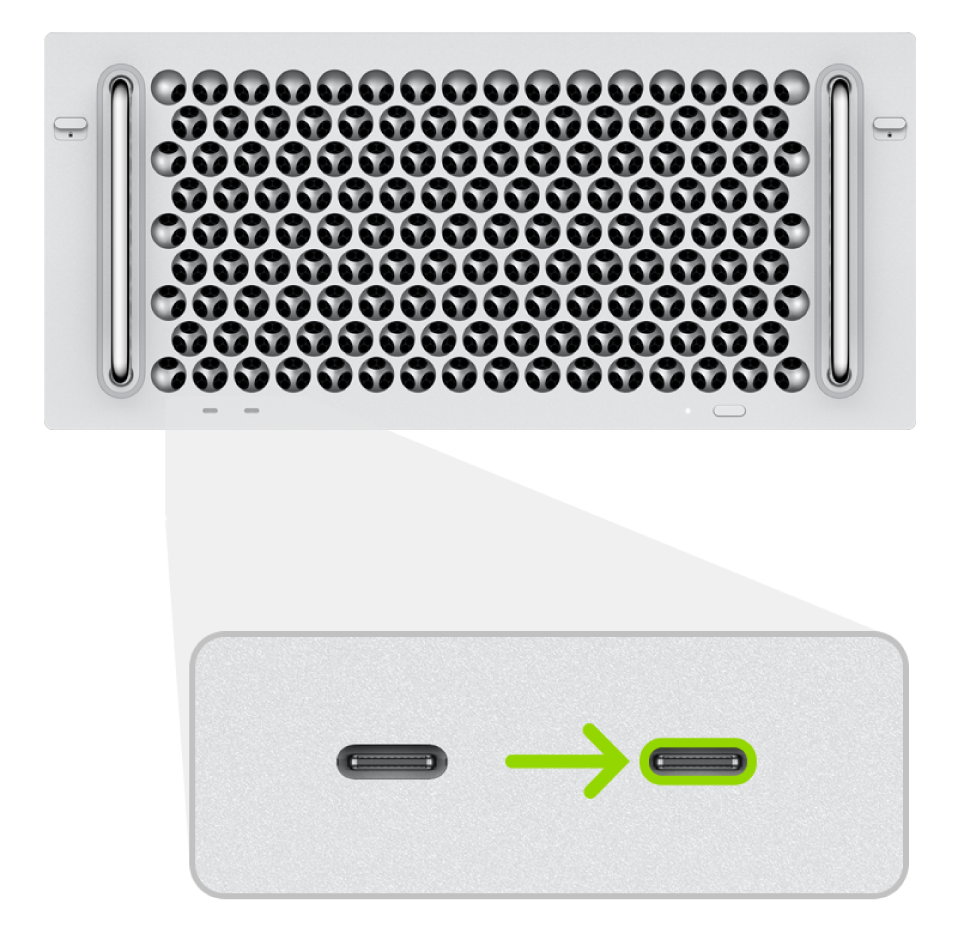
3. While holding down the power button, connect the Mac Pro to power and continue to hold the power button for about 3 seconds.
Note: You won’t see any screen activity from the Mac Pro you are trying to revive or restore.
Step 3: Revive the firmware
- In the Apple Configurator 2
 window on the first Mac, select the DFU icon of the Mac whose chip firmware you want to revive.
window on the first Mac, select the DFU icon of the Mac whose chip firmware you want to revive.

- Do one of the following:
- Choose Actions > Advanced > Revive Device, then click Revive.
- Control-click the selected DFU icon, then choose Advanced > Revive Device, then click Revive.
Note: If you lose power to either Mac during this process, begin the revive process again.
- Wait for the process to complete. During this process, an Apple logo will appear and disappear on the second Mac.
- After the process successfully completes, your Mac will reboot.
Note: If the revive was unsuccessful, proceed to step 4.
- If necessary, use recoveryOS to reinstall macOS.
See the Apple Support article How to reinstall macOS from macOS Recovery.
- Quit Apple Configurator 2 on the first Mac, then unplug any cables and adapters.
Step 4: Restore the firmware and erase all data
- In the Apple Configurator 2
 window on the first Mac, select the DFU icon of the Mac to be restored.
window on the first Mac, select the DFU icon of the Mac to be restored. - Do one of the following:
- Choose Actions > Restore, then click Restore.
- Control-click the selected DFU icon, then choose Actions > Restore, then click Restore.
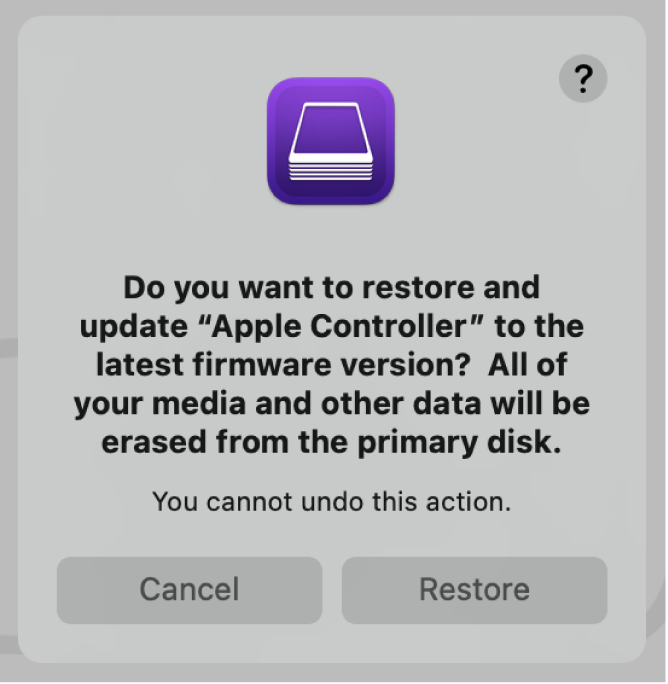
The restore confirmation dialog. Note: If you lose power to either Mac during this process, begin the restore process again.
- Wait for the process to complete. During this process, an Apple logo will appear and disappear on the second Mac.
- After the process completes, your Mac will restart.
- After the Mac restarts, press Shift-Option-Command-R at startup (Internet Recovery) to install the macOS that came with your Mac, or the closest version still available.
See the Apple Support article How to reinstall macOS.
- Quit Apple Configurator 2 and unplug any adapters and cables.

